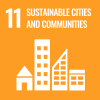Africa and Asia together will account for 86 per cent of all growth in the world’s urban population over the next four decades, adding that this unprecedented increase will pose new challenges in terms of jobs, housing and infrastructure. Africa’s urban population will increase from 414 million to over 1.2 billion by 2050 while that of Asia will soar from 1.9 billion to 3.3 billion, according to the 2011 Revision of the World Urbanization Prospects, produced by the UN Population Division of the Department of Economic and Social Affairs (DESA).
The largest increases in urban population are expected in the following countries: India, China, Nigeria, the United States and Indonesia. Over the next four decades, India will add another 497 million to its urban population, China – 341 million, Nigeria – 200 million, the US – 103 million, and Indonesia – 92 million.
The projected increase in urban populations in India and Nigeria in the next 40 years will be higher than that of the past four decades, a news release on the report pointed out.
“This unprecedented increase in urban population will provide new opportunities to improve education and public services in Africa and Asia, as more concentrated populations become easier to reach,” the news release stated.
It added that this will also pose new challenges of providing urban jobs, housing, energy and infrastructure to mitigate urban poverty, expansion of slums and a deterioration of the urban environment.
“What we are seeing is the very rapid growth of megacities,” the Assistant Secretary-General for Economic Development in DESA, Jomo Kwame Sundaram, told reporters at the launch of the 2011 Revision in New York. He noted that in 1970, only 39 million people lived in so-called megacities with 10 million or more inhabitants – in other words, less than three per cent of the world’s population at that time.
By 2011, 359 million people lived in these megacities – the equivalent to 9.9 per cent of the urban population of the world. In 2025, some 630 million will live in these megacities – some 13.6 per cent of the world’s urban population by then, he stated.
Speaking at the launch, the Chief of DESA’s Population Estimates and Projections Section, Gerhard Heilig, noted that the revision contains the most recent data available since it is based on figures from the 2010 census rounds, including from India and China.
Also, the 2011 Revision, for the first time, includes geographical coordinates for the 633 cities with more than 750,000 inhabitants, he added.
“That doesn’t sound like much,|agree. But for us, it’s really a quantum leap forward,” Mr. Heilig said. Now researchers can link estimates and projections of the population in urban agglomerations to various environmental characteristics, such as proximity to coastal areas, earthquake faults or climate zones.
An initial analysis found that among 450 urban areas with one million or more inhabitants in 2011 (representing 1.4 billion people), 60 per cent, or about 890 million people, are located in regions exposed to at least one major type of natural disaster risk.
With half of humanity living in cities today, urbanization is a critical issue for the UN Conference on Sustainable Development, also known as Rio+20, which will take place from 20 to 22 June in Rio de Janeiro, Brazil.
Cities are where the pressures of migration, globalization, economic development, social inequality, environmental pollution and climate change are most directly felt, according to DESA. Yet, at the same time, they are the engines of the world economy and centres of innovation where many solutions to global problems are being piloted.
“The launch of the World Urbanization Prospects is timely because world leaders, along with thousands of participants from governments, the private sector, civil society organizations and other groups, will come together to shape how we can reduce poverty, advance social equity and ensure environmental protection on an ever more crowded planet,” stated the Secretary-General of Rio+20, Sha Zukang, in a news release.
“We expect world leaders to come up with concrete action plans to realize sustainable cities for the future we want,” he added.
Source: UN News
 Welcome to the United Nations
Welcome to the United Nations
